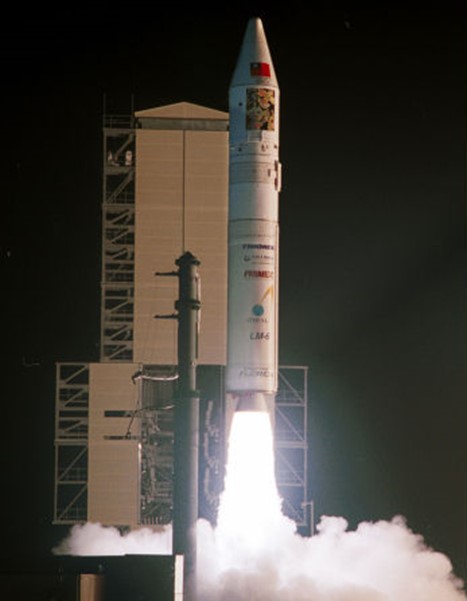ATHENA I FACT SHEET
By Cliff Lethbridge

Athena I Launch, Photo Courtesy David Wong
Classification: Space Launch Vehicle
Length: 65 feet
Diameter: 7 feet, 9 inches
Date of First Cape Canaveral Launch: January 26, 1999
Date of Final Cape Canaveral Launch: January 26, 1999
Number of Cape Canaveral Launches: 1
What eventually became known as the Athena rocket program (not to be confused with the Atlantic Research Corporation Athena ballistic missile research program of the mid-1960’s) began in January, 1993 as Lockheed decided to capitalize on its rocketry potential. Lockheed believed that the timing was right to apply its cumulative solid-propellant Polaris, Poseidon and Trident missile technology to the ever-emerging field of launching relatively lightweight payloads into space. The initial vehicle program that emerged was named Lockheed Launch Vehicle (LLV). After Lockheed merged with Martin Marietta to form Lockheed Martin, the program was renamed Lockheed Martin Launch Vehicle (LMLV). The core launch vehicle was named LMLV-1, with a larger version named LMLV-2. LMLV-1 was later renamed Athena I, while LMLV-2 was renamed Athena II. A third version, called the Athena III, has also been introduced but to date has not been launched from Cape Canaveral.
The Athena I was a two-stage, solid-fueled rocket capable of carrying a maximum 1,750-pound payload into low-Earth orbit. A Thiokol Castor 120 solid rocket motor served as the Athena I first stage. The first stage was 28 feet, 9 inches long by 7 feet, 9 inches wide and burned Class 1.3 Hydroxyl-terminated polybutadiene (HTPB) solid propellant. The first stage could produce a thrust of 435,000 pounds at launch. The first stage motor was housed in a composite case and was steered by blowdown cold gas-powered hydraulic thrust vector control (TVC) actuators. In a typical flight profile, the first stage burned out about 90 seconds after launch, after which the vehicle began an unpowered coast period. The first stage remained attached to the vehicle during this coast to provide aerodynamic stability.
A Pratt and Whitney Orbus 21D solid rocket motor served as the Athena I second stage. The second stage was 10 feet, 4 inches long by 7 feet, 8 inches wide and, like the first stage, burned Class 1.3 HTPB solid propellant. The second stage could produce a thrust of 43,723 pounds. The second stage motor was housed in a composite case and employed a carbon phenolic nozzle steered by electromechanical TVC actuators. In a typical flight profile, the second stage was fired about 200 seconds after launch and about two seconds following first stage separation. The second stage burned out about 145 seconds after was is fired. The second stage separated less than one second after it burned out, at which time an Orbit Adjust Module (OAM) attached to the payload was fired. The OAM housed a Primex Technologies attitude control system, as well as an avionics subsystem. The OAM included guidance and navigation controls, batteries, telemetry transmitters, command and destruct receivers and antennas.
The OAM could be ignited, shut down and restarted to perform orbital injection attitude corrections, roll control, velocity trim and orbit circularizing maneuvers. The OAM could carry a maximum 960 pounds of hydrazine liquid fuel. After the OAM completed its role, it separated from the payload and executed a collision avoidance maneuver away from the payload until its fuel was depleted. The Athena I employed a standard payload fairing which was 14 feet, 1 inch long by 6 feet, 6 inches wide. Considered a “stack and shoot” type of launch vehicle, the Athena I was designed to be launched in as little as 30 days after the first stage arrived at the launch site.


